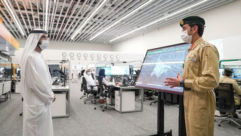Beating the Clock
Apr 1, 1998 12:00 PM,
Danny Abelson
Not many college basketball teams can boast the kind of arena that theBadgers of the University of Wisconsin received when the Kohl Center openedthis past January in Madison, WI. The 450,000 ft squared (41,805 metersquared), $76 million multi-use facility ($25 million of which came from U.S. senator and businessman Herb Kohl, a 1956 graduate of the university)seats 16,500 Badgers fans and others on three levels below its 90 foot (27m) ceiling, some of whom are lucky enough to be ensconced in the 36 16-seatluxury suites that dot the structure’s interior. The facility featuresreception halls, a retail store, auxiliary gymnasium and CCTV capabilities.
“Well-planned, coordinated efforts are essential to projects of thisscale,” observed Al Fish, associate athletic director for the universityand a veteran manager of a Big Ten university athletic department. “Wechose a design/build approach to go with the fast-track constructionscheduling we went with for every aspect of the arena. Construction startedin April 1996, and was supposed to be finished by January of this year. Theonly way we were going to make that deadline was to fast track it, and thereason the design/build approach worked as well as it did was because of ahigh degree of pre-planning and because everyone on the project worked as ateam.”
As a result, what normally would have taken three years was accomplished in21 months. Pre-planning and subcontractor coordination were essential. Fishand the university had chosen the architectural/engineering companies(H.O.K., Kansas City, MO, and Venture Architects, Milwaukee, with leadarchitect George Heinlein), the project management company (Hammes,Milwaukee) and the construction company (Oscar J. Boldt, Milwaukee) afterthe university had assembled a comprehensive operations plan for the arena.
Fish said that audio was a major aspect of that plan. “We knew we weregoing to need a high degree of voice clarity and articulation in a systemthat was going to go into a very loud building. And because this is amulti-purpose facility, it would have to serve as a very musical system forentertainment events as well, and that’s exactly what we got because theTurbosound components were good and the people implementing them worked asa team.”
Fish’s nearby sound expert was Audio Independence of Middleton, WI,exclusive U.S. distributor for British-made Turbosound system componentsand MC-Squared power amps, which constitute the majority of theloudspeakers and power amps. Audio Independence president Danny Abelson hadworked with Fish in 1994 on the renovation of the university’s 80,000-seatCamp Randall Stadium, providing a Turbosound Flashlight sound systeminstalled by a local contractor. When Audio Independence was brought intothe Kohl Center project as the sound system components supplierconstruction was well under way, but Abelson saw from the scope of theproject that it required another entity to implement and install theequipment.
The result was the entry of Chicago-area Ancha Electronics, one of the fivelargest A-V systems installers in the United States. Ancha’s purview wouldbe the installation of all broadcast wiring systems-a massive project inand of itself, with more than 400,000 feet (122,000 m) of mic/line cable,200,000 feet (61,000 m) of loudspeaker wire and 30,000 feet (9,144 m) oftriax camera cable-the arena’s interior RF and CCTV systems, which Anchadesigned based on a university specification, the main PA system suppliedby Audio Independence and the arena’s auxiliary systems, including pagingand media room interface.
“We teamed with Ancha to accomplish what was truly a massive job,” remarkedAbelson. “The way we both entered the picture dovetailed well with the waythe entire construction project was proceeding. Instead of the typicalbid-and-spec process that perhaps gives a client the lowest price but notalways the best result, Ancha, the University of Wisconsin and the generalcontractors worked with us to establish a cooperative effort.”
Ancha Electronics implemented all of the wire and cabling runs for theentire project and designed and installed the sound system headend around aPeavey MediaMatrix controller run by a Crestron microprocessor system.
“From our point of view, the project needed as much pre-planning aspossible,” explained Bill Gillette, sales manager for Ancha. “We put inhundreds of thousands of feet of cabling, much of it as concrete waspoured, when we were installing conduit. We knew the facility would be anattraction to broadcast operators, so we paid particularly close attentionto allowing for good video interfaces, such as the two huge Hoffman boxescontaining the video patch panel, which allows TV production trucks to pluginto the building’s 300-plus video lines.”
Sound system install teamAudio Independence and Ancha Electronics worked on a design that specifiedfour main clusters dead-hung from the arena’s ceiling. The installation ofthe sound system hinged around semi-weekly team meetings among theprincipals, anchored by project construction supervisor John Rodell ofBadger Sports Development, the joint venture LLC between Boldt and Hammes.
An example of what came from these regular conclaves is found in thearena’s ceiling construction from which the four main four-way, fullyactive clusters of the sound system would hang. The spec called for each ofthe largest clusters on the north and south ends of the interior 51 feet(15.5 m) apart to be fitted with five Turbosound TSW-721 21 inch (533 mm)bass bins, five Turbosound Flashlight 780 boxes and five Turbo-soundTFL-760HM high/mid downfill enclosures. The east and west clusters, 43 feet(15 m) from each other, consisted of four Turbosound ESW-721 bassenclosures, four Turbosound TFL-768 mid-high enclosures and fourTurbo-sound TFL-760HM downfill enclosures.
“The north-south clusters had the longest throw,” said Abelson. “Butbetween the four clusters, the design indicated that we could cover theentire lower seating areas right to the edge of the floor.”
Audio Independence had computer- modeled the room and combined that withthe experience provided by Turbosound’s senior design engineer DannyCooklin and Audio Independence customer service engineer Paul Giansante,who described the Turbo-sound enclosures’ response as “incrediblypredictable and very tight, with 25 degrees of horizontal dispersion on theTSS-780H cabinets and 50 degrees on the TFL760H enclosures. The modelingprogram simply backed up what we already knew about the system components’response based on past experience.”
The main clusters were augmented by two delay rings consisting of 28Turbosound Impact 50 two-way enclosures mounted under the upper balcony tocover seats in the direct sonic shadow of the balcony, and a second upperring consisting of 28 Turbosound TMI-102 12 inch (305 mm) two-wayenclosures suspended from the roof to cover upper-deck seating. The 28separate delay settings were determined by Giansante and Ancha’s projectmanager, Jack McCallum, using a TEF system and range between 60 ms and 120ms.
The meetings discussed how to keep the sound system faithful to the goalsit was given by the various parties, including high articulation, highvolume and musicality. The consensus resulted in the choice of a corrugatedroofing material 3 inches (76 mm) deep and 6 inches (152 mm) wide withperforations that reveal a fiberglass-filled core.
“That gave us the acoustical softness needed to offset the hard surfaces ofthe rest of the interior of the arena and provide musicality to the spacethat the PA system could work with,” explained Rodell. “It also gave enoughstrength to support the size PA that Turbosound had determined would beneeded to give the arena the required levels of volume and intelligibility.The ceiling was designed with a 93,000 pound (41,850 kg) live-loadcapacity.”
The system was dead-hung on load-certified Turbosound flybars by riggingcontractor Peter Albrecht of Milwaukee, and it went up in just three days.An initial consideration was to mount the cluster on motorized winches forcomponent replacement if necessary. Another outcome of the regularmeetings, however, was the determination that based on everyone’sexperience with Turbosound enclosures in applications such as theuniversity’s outdoor football field, the system’s reliability eliminatedthe need for movable clusters.
The MC-Squared power amps for the clusters and delay rings were mounted inthe catwalk area above the scoreboard to minimize loudspeaker cable runsand the effects of line loss.
“The MC-Squared MC 450, MC650 and MC1250 amps all have digitally convertedfront ends, which allows the operator to manage all of them from a singlePC screen in the audio control room,” explained Abelson.
That control room was another result of teamwork decisions. The initialspecification called for sound, video and scoreboard control to be situatedin a low seat-loss position above the upper deck, but it was discoveredthat the difficult access to the location would fail to comply with theFederal Americans with Disabilities Act.
“It’s a perfect example of how coordinating the contracting teams paidoff,” said McCallum. “The choice of that location made perfect sense froman architectural point of view, and to the facility owners because it was anon-revenue-producing location. Then the ADA issue developed. As a team, wereviewed other possibilities and found that we could share space with aconcessions supply room in the south concourse that had a direct line ofsight to the floor.”
The audio control room features a Crest Century Series console, in additionto a variety of compressors, with a 360 Systems Instant Replay hard diskrecorder. An extensive Clear-Com multichannel intercom system providesproduction communications facilities throughout the building.
The Kohl Center’s debut came in the form of a Badgers game on Jan. 17,1998, and since then, the facility has hosted sporting and entertainmentevents, all of which have proven that the sound system can meet itsspecified goal of making the arena a truly multifunction facility.









